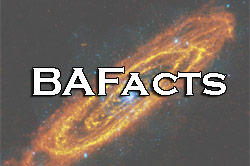Create a free profile to get unlimited access to exclusive videos, sweepstakes, and more!
BAFact Math: The Sun is 12 *trillion* times brighter than the faintest star
you can see

 [BAFacts are short, tweetable astronomy/space facts that I post every day. On some occasions, they wind up needing a bit of a mathematical explanation. The math is pretty easy, and it adds a lot of coolness, which I'm passing on to you! You're welcome.]
[BAFacts are short, tweetable astronomy/space facts that I post every day. On some occasions, they wind up needing a bit of a mathematical explanation. The math is pretty easy, and it adds a lot of coolness, which I'm passing on to you! You're welcome.]
Today's BAFact: The Sun is 12 trillion times brighter than the faintest star you can see with your naked eye.
In yesterday's BAFact, I showed how the Sun is about 400,000 times brighter than the full Moon - and I showed my math. That's an amazing brightness difference, but while I was writing it I had to wonder: how much brighter is the Sun than the faintest star you can see?
The faintest stars visible to the naked eye have a magnitude of about 6. This depends on lots of stuff, like how dark the sky is, how good your eyesight is, and so on. Some people with excellent vision can see stars down to magnitude 7, and there are reports of a few extraordinary people who can see even fainter. But on a dark night, the average person can just barely see 6th magnitude stars.
Let's use that number then. All we have to do is plug that into the equation I gave yesterday (and remembering that the Sun has a magnitude of -26.7):
Brightness ratio = 2.512(6 - (-26.7)) = 2.51232.7 = 12 trillion
Yegads! That's 12,000,000,000,000 times brighter!
Now, to be fair, that's not really the brightness range your eyes can detect. You can't look right at the Sun easily or comfortably; it's simply too bright. So the range of brightness your eye can see is probably smaller.
We can put a lower limit on it easily enough using the Moon. The Moon is the second brightest object in the sky, and we know we can look at that easily enough, so let's do that math (the Moon's magnitude is -12.7 when it's full):
Brightness ratio = 2.512(6 - (-12.7)) = 2.51218.7 = 30 million
Wow. So you can comfortably see objects over a brightness range of 30 million. That's impressive! The eye is a pretty cool little machine.
As an aside, your eye isn't linear; it's logarithmic (in reality, it's more complicated than this, and I'm simplifying, but close enough). In other words, a star giving off twice as much light doesn't look twice as bright as another. The way your eye responds to light squeezes down the scale, making it easier to see fainter and brighter objects at the same time.
So how faint do objects get? Ah, that'll be tomorrow's BAFact. Stay tuned!
Related Posts:
- BAFact Math: Jupiter is big enough to swallow all the rest of the planets whole
- BAFact math: Give him an inch and heâll take a light year
- BAFact math: how big does the Sun look from Pluto?
- BAFact math: How bright is the Sun from Pluto?


























